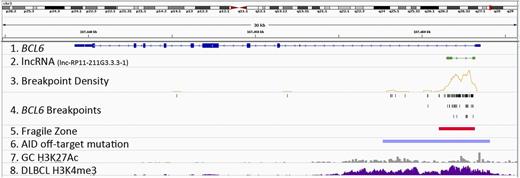To the editor:
We recently published a study showing that BCL6 translocations occur at distinct sequence motifs within intron 1 of the BCL6 gene that are recognized and deaminated by activation-induced cytidine deaminase (AID).1 It has been unclear, however, why these breakpoints cluster in an ∼2-kb major breakpoint region (MBR) within this 11-kb-long intron. Recent studies in mouse models of AID-dependent translocations suggest that AID-induced breaks may target intragenic regions of convergent transcription and/or H3K27Ac-defined super-enhancers.2,3 Indeed, analysis of the human BCL6 gene identified regions of convergent transcription, as defined by global run-on sequencing (GRO-seq) (a measure of global transcription) and/or super-enhancers overlapping with BCL6 intron 1, but these regions are at least threefold larger than the ∼2-kb breakpoint region identified in actual human lymphoma samples (compare lines 3-5 with lines 6-8 in Figure 1). Looking in the LNCipedia long noncoding RNA (lncRNA) database,4 we found that the lncRNA gene lnc-RP11-211G3.3.1-1 (transcribed from the positive strand, which is opposite to the transcription direction of the BCL6 gene) is located where >87% of the translocations occur. Remarkably, the boundaries of this lncRNA match the boundaries of the BCL6 translocation zone quite precisely (compare line 2 with lines 3-5 in the Figure 1). Moreover, this lncRNA is a natural transcript in human diffuse large B-cell lymphoma (DLBCL); expression of lnc-RP11-211G3.3.1-1 was detected in the germinal cell B-cell type of DLBCL and at a lower level in the activated B-cell type of DLBCL.5 Other than its expression and precise correlation with the BCL6 translocation zone as described in this letter, there are no currently published data about this novel lncRNA.
BCL6 translocation fragile zone overlaps with lncRNA transcript. The tracks in this Integrative Genomics Viewer snapshot show: Line 1, the BCL6 gene (blue, transcribed from negative strand); Line 2, the lncRNA (shown in green and transcribed from positive strand; gene called lnc-RP11-211G3.3.3-1); Line 3, the density of patient BCL6 translocation breakpoints adapted from previous publication1 (tan line graph illustrating the number of BCL6 breakpoints counted in 500-bp sliding window with steps of 50 bp; the y-axis range of this graph is 0-48); Line 4, the actual location of BCL6 breakpoints described in line 3 (black vertical lines are distributed over 3 layers for clarity); Line 5, the fragile zone of 2156 bp that encompasses 90% of the breakpoints (red bar); Line 6, AID off-target mutation zone in the Ramos cell line (light purple bar)5 ; Line 7, the H3K27Ac chromatin immunoprecipitation–seq read density in human tonsil germinal center B cells (gray, GSM1519135)5 ; Line 8, the H3K4me3 chromatin immunoprecipitation–seq read density in the human lymphoma (DLBCL) cell line, OCI-Ly1 (dark purple); the y-axis range of this graph is 0 to 60.1 The lncRNA gene overlaps with >87% of the BCL6 breakpoints.
BCL6 translocation fragile zone overlaps with lncRNA transcript. The tracks in this Integrative Genomics Viewer snapshot show: Line 1, the BCL6 gene (blue, transcribed from negative strand); Line 2, the lncRNA (shown in green and transcribed from positive strand; gene called lnc-RP11-211G3.3.3-1); Line 3, the density of patient BCL6 translocation breakpoints adapted from previous publication1 (tan line graph illustrating the number of BCL6 breakpoints counted in 500-bp sliding window with steps of 50 bp; the y-axis range of this graph is 0-48); Line 4, the actual location of BCL6 breakpoints described in line 3 (black vertical lines are distributed over 3 layers for clarity); Line 5, the fragile zone of 2156 bp that encompasses 90% of the breakpoints (red bar); Line 6, AID off-target mutation zone in the Ramos cell line (light purple bar)5 ; Line 7, the H3K27Ac chromatin immunoprecipitation–seq read density in human tonsil germinal center B cells (gray, GSM1519135)5 ; Line 8, the H3K4me3 chromatin immunoprecipitation–seq read density in the human lymphoma (DLBCL) cell line, OCI-Ly1 (dark purple); the y-axis range of this graph is 0 to 60.1 The lncRNA gene overlaps with >87% of the BCL6 breakpoints.
The correlation of lnc-RP11-211G3.3.1-1 with the BCL6 translocation zone supports the view that convergent transcription is an important factor for defining some translocation fragile zones.2 Interestingly, a convergent arrangement where 2 promoters are close together will eventually become divergent when the 2 RNA polymerases progress away from the zone of overlap. Divergent configurations result in increased DNA melting and single-stranded DNA,6 which are necessary for AID action.7 Our initial report described the AID motifs in the human BCL6, providing evidence that AID is responsible for the breaks at the human BCL6 gene.1 This additional note adds that the fragile zone in which AID causes chromosome breaks may require the transcription on both strands that may then permit not simply AID mutation (involving only 1 strand of the DNA), but AID action on both DNA strands to permit a double-strand DNA break.
Authorship
Acknowledgments: This study was supported by the National Institutes of Health (NIH) National Cancer Institute grant CA100504 (M.R.L.), by NIH National Institute of General Medical Sciences grant GM56984 (M.R.L.), and by the St. Baldrick’s Foundation and NIH CHLA K12 Child Health Research Career Development Awards (C.P.).
Contribution: Z.L. performed research and bioinformatics; D.C. provided bioinformatics support; C.P. and D.C. provided key information about the location of the lncRNA at BCL-6; N.R.P. and H.A.G. provided key advice; and all authors contributed to the writing of the manuscript.
Conflict-of-interest disclosure: The authors declare no competing financial interests.
Correspondence: Michael R. Lieber, University of Southern California Keck School of Medicine, 1441 Eastlake Ave, MC9176, Los Angeles, CA 90089-9176; e-mail: lieber@usc.edu.

